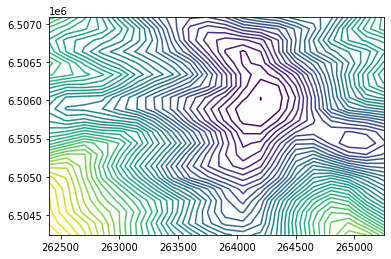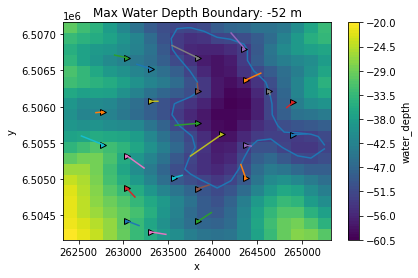Optimization with exclusion zones
Try this yourself (requires google account)
In this example, the bathymetric optimization problem is solved for a maximum water depth permissible and with the addition of exlusion zones, which add boundary constraints to the optimization problem. The exclusion zone is characterized for having a larger water depth than allowed.
Install TOPFARM if needed
[1]:
# Install TopFarm if needed
import importlib
if not importlib.util.find_spec("topfarm"):
!pip install git+https://gitlab.windenergy.dtu.dk/TOPFARM/TopFarm2.git
Install packages if running in Colab
[2]:
try:
RunningInCOLAB = 'google.colab' in str(get_ipython())
except NameError:
RunningInCOLAB = False
[3]:
%%capture
if RunningInCOLAB:
!pip install git+https://gitlab.windenergy.dtu.dk/TOPFARM/PyWake.git
!pip install git+https://gitlab.windenergy.dtu.dk/TOPFARM/TopFarm2.git
!pip install scipy==1.6.3 # constraint is not continuous which trips vers. 1.4.1 which presently is the default version
import os
os.kill(os.getpid(), 9)
First we import basic Python elements and some TOPFARM classes
[4]:
import numpy as np
import matplotlib.pyplot as plt
import time
from topfarm.cost_models.cost_model_wrappers import CostModelComponent
from topfarm.easy_drivers import EasyScipyOptimizeDriver
from topfarm import TopFarmProblem
from topfarm.plotting import NoPlot, XYPlotComp
from topfarm.constraint_components.boundary import XYBoundaryConstraint, InclusionZone, ExclusionZone
from topfarm.constraint_components.spacing import SpacingConstraint
from topfarm.examples.data.parque_ficticio_offshore import ParqueFicticioOffshore
from py_wake.deficit_models.gaussian import IEA37SimpleBastankhahGaussian
from py_wake.examples.data.iea37._iea37 import IEA37_WindTurbines
C:\Users\mikf\Anaconda3\envs\om3\lib\site-packages\openmdao\utils\general_utils.py:128: OMDeprecationWarning:simple_warning is deprecated. Use openmdao.utils.om_warnings.issue_warning instead.
C:\Users\mikf\Anaconda3\envs\om3\lib\site-packages\openmdao\utils\notebook_utils.py:157: UserWarning:Tabulate is not installed. Run `pip install openmdao[notebooks]` to install required dependencies. Using ASCII for outputs.
Setting up the site and exclusion zone
To set up the exlusion zone, we use polygon tracing for the maximum water depth by utilizing the boundary_type=’multipolygon’ keyword.
[5]:
#setting up the site and the initial position of turbines
site = ParqueFicticioOffshore()
site.bounds = 'ignore'
x_init, y_init = site.initial_position[:,0], site.initial_position[:,1]
boundary = site.boundary
#Wind turbines and wind farm model definition
windTurbines = IEA37_WindTurbines()
wfm = IEA37SimpleBastankhahGaussian(site, windTurbines)
#parameters for the AEP calculation
wsp = np.asarray([10, 15])
wdir = np.arange(0,360,45)
n_wt = x_init.size
#setting up the exclusion zone
maximum_water_depth = -52
values = site.ds.water_depth.values
x = site.ds.x.values
y = site.ds.y.values
levels = np.arange(int(values.min()), int(values.max()))
max_wd_index = int(np.argwhere(levels==maximum_water_depth))
cs = plt.contour(x, y , values.T, levels)
lines = []
for line in cs.collections[max_wd_index].get_paths():
lines.append(line.vertices)
plt.close()
xs = np.hstack((lines[0][:,0],lines[1][:,0]))
ys = np.hstack((lines[0][:,1],lines[1][:,1]))
Now we set up the objective function, CostModelComponent and TopFarmProblem.
[7]:
def aep_func(x, y, **kwargs):
simres = wfm(x, y, wd=wdir, ws=wsp)
aep = simres.aep().values.sum()
water_depth = np.diag(wfm.site.ds.interp(x=x, y=y)['water_depth'])
return [aep, water_depth]
#parameters for the optimization problem
tol = 1e-8
ec = 1e-2
maxiter = 30
min_spacing = 260
#Cost model component and Topfarm problem
cost_comp = CostModelComponent(input_keys=[('x', x_init),('y', y_init)],
n_wt=n_wt,
cost_function=aep_func,
objective=True,
maximize=True,
output_keys=[('AEP', 0), ('water_depth', np.zeros(n_wt))]
)
problem = TopFarmProblem(design_vars={'x': x_init, 'y': y_init},
constraints=[XYBoundaryConstraint([InclusionZone(boundary), ExclusionZone(np.asarray((xs,ys)).T)], boundary_type='multi_polygon'),
SpacingConstraint(min_spacing)],
cost_comp=cost_comp,
n_wt = n_wt,
driver=EasyScipyOptimizeDriver(optimizer='SLSQP', maxiter=maxiter, tol=tol),
plot_comp=XYPlotComp(),
expected_cost=ec)
INFO: checking out_of_order
INFO: checking system
INFO: checking solvers
INFO: checking dup_inputs
INFO: checking missing_recorders
INFO: checking unserializable_options
INFO: checking comp_has_no_outputs
INFO: checking auto_ivc_warnings
Now we run the optimization
[8]:
tic = time.time()
cost, state, recorder = problem.optimize()
toc = time.time()
print('Optimization took: {:.0f}s'.format(toc-tic))
INFO: checking out_of_order
INFO: checking system
INFO: checking solvers
INFO: checking dup_inputs
INFO: checking missing_recorders
INFO: checking unserializable_options
INFO: checking comp_has_no_outputs
INFO: checking auto_ivc_warnings
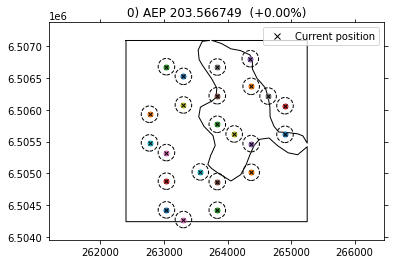
Iteration limit reached (Exit mode 9)
Current function value: [-23868.45951881]
Iterations: 30
Function evaluations: 30
Gradient evaluations: 30
Optimization FAILED.
Iteration limit reached
-----------------------------------
Optimization took: 44s
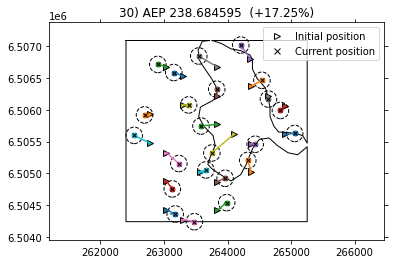
Here we can see the exclusion zone and how the optimized turbine positions stay away from this area. The turbines are positioned at the boundaries and the improvement in AEP is of 4.88% compared to the baseline.
We can use the recorder to plot the evolution of the water depth with each iteration.
[9]:
plt.plot(recorder['water_depth'].min((1)))
plt.plot([0,recorder['water_depth'].shape[0]],[maximum_water_depth, maximum_water_depth])
plt.xlabel('Iteration')
plt.ylabel('Max depth [m]')
[9]:
Text(0, 0.5, 'Max depth [m]')
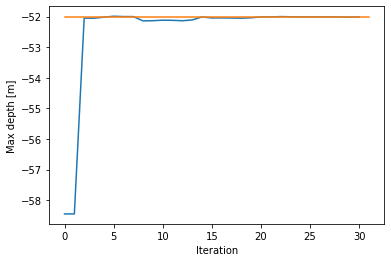
We can also visualize the initial vs optimized layout as countour plots that show the water depth. Note how it is clear how the optimized positions do not cross the boundary set for the water depth.
[10]:
cs = plt.contour(x, y , values.T, levels)
fig2, ax2 = plt.subplots(1)
site.ds.water_depth.plot(ax=ax2, levels=100)
ax2.plot(xs, ys)
problem.model.plot_comp.plot_initial2current(x_init, y_init, state['x'], state['y'])
ax2.set_title(f'Max Water Depth Boundary: {maximum_water_depth} m')
[10]:
Text(0.5, 1.0, 'Max Water Depth Boundary: -52 m')
